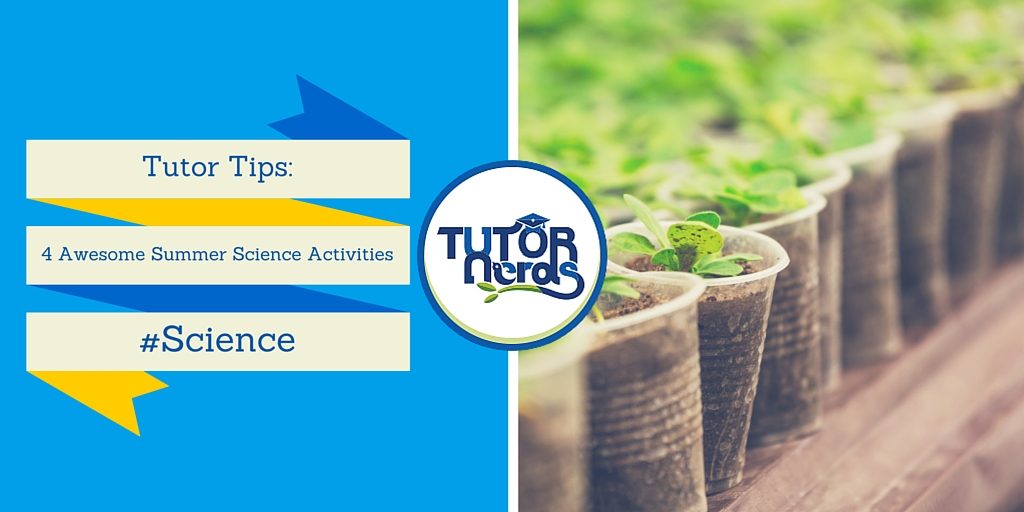Tips from an Irvine Science Tutor: 4 Awesome Summer Science Activities


Summertime and the great outdoors can offer students ample opportunity to hone their scientific abilities. It’s important that kids get a chance just to relax and soak in some sunshine while school is out of session but there are plenty of educational activities they can do without the four walls of the classroom environment. Summer science activities can be social and interactive and encourage students to develop a love of science without the pressure of due dates or exams. There are several activities parents can do with their children that make the summer more fun and productive simultaneously.
Although it sounds pretty intense, field research just means studying outside of the home or classroom. Depending on a student’s grade level, there are tons of things they can look for out in nature. Students can observe the types of plants that grow in and around their neighborhood and even take a photo or draw a picture. They can observe the difference between various types of soil in a park or on a nature walk and learn about the different elements required to make plants grow, such as water and sunlight. Students can even choose some seeds at the supermarket or garden center and plant flowers or vegetables in a backyard garden and then measure the plants as they grow. Summer field research is about kids learning that there’s a lot more to science than what is found in a textbook (READ: 5 Reasons to Play Sports Over the Summer).
During the school year, many kids don’t get as much social time as they might need. Summer science projects are a great way for kids to work on social skills such as sharing and working as a team without the pressure of a grade at the end of the project. For instance, a few kids in the neighborhood could get together and create a safe and age-appropriate science experiment under the supervision of a parent and learn how to share the various responsibilities of the project while still having fun. Students can get the same type of socialization in an organized setting at an outdoor summer science camp.
A simple yet effective way of learning about the Earth is for students to study what they see outside. For example, is the Earth made up of dry soil and a mountainous ridgeline or marshy wetlands home to fish and birds? Since summer time allows students to slow down and live in the present, they can spend some time learning what makes up the Earth by simply being outside. Kids who live in an urban setting can compare the differences between the city and a local park or nature preserve. Some examples for students living in Southern California include:
The San Joaquin Marsh in Irvine
The San Diego Botanic Gardens in Encinitas
During the summer, students can also think about some things that are put right in front of them but that they might not otherwise think of when they’re busy with academic activities. For instance, students living in Southern California will be relatively close to the Pacific Ocean. They can learn about ocean tides in person rather than in a textbook. Parents can look up low and high tide with their kids on some free apps and visit the ocean at different times of the day to compare. They can then do some at-home research and see how the moon affects the local tide. Additionally, kids can study their local microclimate by looking at the night and daytime temperature or taking a trip from the beach to the desert to see different flora and fauna that grow in different temperatures. In addition to learning about science and nature, students can have some quality time with their family.
Summer is the perfect time for students to catch up and get ahead in their science studies. Book your Irvine summer science tutor from TutorNerds today!
100% Satisfaction Guarantee
You’ll love your tutor, or you don’t pay.

We will evaluate your situation and answer any questions. We will then individually match you with one of our tutors. Your tutor will recommend the best strategies for you based on your goals. You’ll work with the same tutor ongoing and you can schedule directly with your tutor.
100% Satisfaction Guarantee – You’ll love your tutor, or you don’t pay
| Cookie | Duration | Description |
|---|---|---|
| cookielawinfo-checkbox-analytics | 11 months | This cookie is set by GDPR Cookie Consent plugin. The cookie is used to store the user consent for the cookies in the category "Analytics". |
| cookielawinfo-checkbox-functional | 11 months | The cookie is set by GDPR cookie consent to record the user consent for the cookies in the category "Functional". |
| cookielawinfo-checkbox-necessary | 11 months | This cookie is set by GDPR Cookie Consent plugin. The cookies is used to store the user consent for the cookies in the category "Necessary". |
| cookielawinfo-checkbox-others | 11 months | This cookie is set by GDPR Cookie Consent plugin. The cookie is used to store the user consent for the cookies in the category "Other. |
| cookielawinfo-checkbox-performance | 11 months | This cookie is set by GDPR Cookie Consent plugin. The cookie is used to store the user consent for the cookies in the category "Performance". |
| viewed_cookie_policy | 11 months | The cookie is set by the GDPR Cookie Consent plugin and is used to store whether or not user has consented to the use of cookies. It does not store any personal data. |

